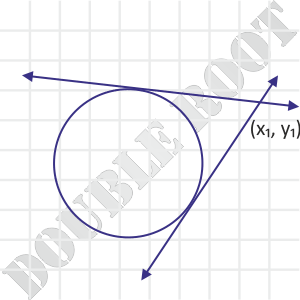This lesson will talk about tangents to a circle from an external point.
We’re interested in three things – equations of the tangents, the angle between them, and also their length. As usual, everything will be followed by lots of examples. I’ll divide the lesson into three parts for easy reading.
We begin…
Let’s call our friend x2 + y2 = a2 back. We’re interested to find the equation of the tangent from an external point, say (x1, y1).

We won’t establish any formula here, but I’ll illustrate two different methods, first using the slope form and the other using the condition of tangency.
Method 1
Recall that the equation of the tangent to this circle will be y = mx ± a\(\small \sqrt{1+m^2}\) (slope form).
We do not know the slope. Instead, we know that it is drawn from the point (x1, y1). Therefore, the coordinates must satisfy the equation of the tangent, that is y1 = mx1 ± a\(\small \sqrt{1+m^2}\)
Now, all we have to do is solve this equation for ‘m’, giving us the equations of the tangents.
But there’s a subtle catch. Note that to solve the above equation we’ll almost always have to do squaring after rearrangement of terms, as follows:
y1 – mx1 = ±a\(\small \sqrt{1+m^2}\)
(y1 – mx1)2 = a2(1 + m2)
The last equation, being a quadratic, will give us two roots, say m1 and m2, which makes sense, as there will be two tangents from an external point.
But if we plug back in the values in the original equation, i.e. the slope form, we will get four different equations:
y = m1x + a\(\small \sqrt{1+{m_1}^2}\)
y = m1x – a\(\small \sqrt{1+{m_1}^2}\)
y = m2x + a\(\small \sqrt{1+{m_2}^2}\)
y = m2x – a\(\small \sqrt{1+{m_2}^2}\)
Four tangents, which is kind of impossible. So where did we go wrong?
The problem lies in squaring equations.
Whether we square y1 – mx1 = +a\(\small \sqrt{1+m^2}\) [1] or y1 – mx1 = –a\(\small \sqrt{1+m^2}\) [2], we’ll get the same quadratic equation: (y1 – mx1)2 = a2(1 + m2) which will give the same set of roots, say m1 and m2, for both [1] and [2]. But one of them may be the solution for [1] and the other for [2], or both may satisfy [1] or both [2]. Which is why two of the four equations obtained above will be incorrect.
Now there are two ways to get around this. Either substitute the coordinates (x1, y1) in each of the four equations and check which two are correct, which is kind of tedious. Or, simply use the point-slope equation of the line for both the values of m. The required equations will be:
(y – y1) = m1(x – x1) and (y – y2) = m2(x – x2). This is much simpler.
Don’t worry if you’re confused. Things will get better in the examples. Now here’s the second method.
Method 2
We know that any line through the point (x1, y1) is (y – y1) = m(x – x1) (the point-slope form). Now we’re interested in the value of m for which this line touches the given circle.
All we have to do is apply the condition of tangency – the distance of the line from the center of the circle must be equal to its radius.
On applying the conditions, we get|y1 – mx1|/ \(\small \sqrt{1+m^2}\) = a or (y1 – mx1)2 = a2(1 + m2), the exact same equation obtained in the previous method.
Solving the equation will give us two values again, say m1 and m2, and plugging these values back into the first equation will give us the two tangents: (y – y1) = m1(x – x1) and (y – y2) = m2(x – x2).
Note that the second method has come from geometrical conditions, which will not work in the case of other conic sections – parabola, ellipse and hyperbola, but the first one will. Anyways, we’ll worry about them later.
And, we’re done for this part of the lesson. The next one will talk about angle between tangents from an external point.
\(\)